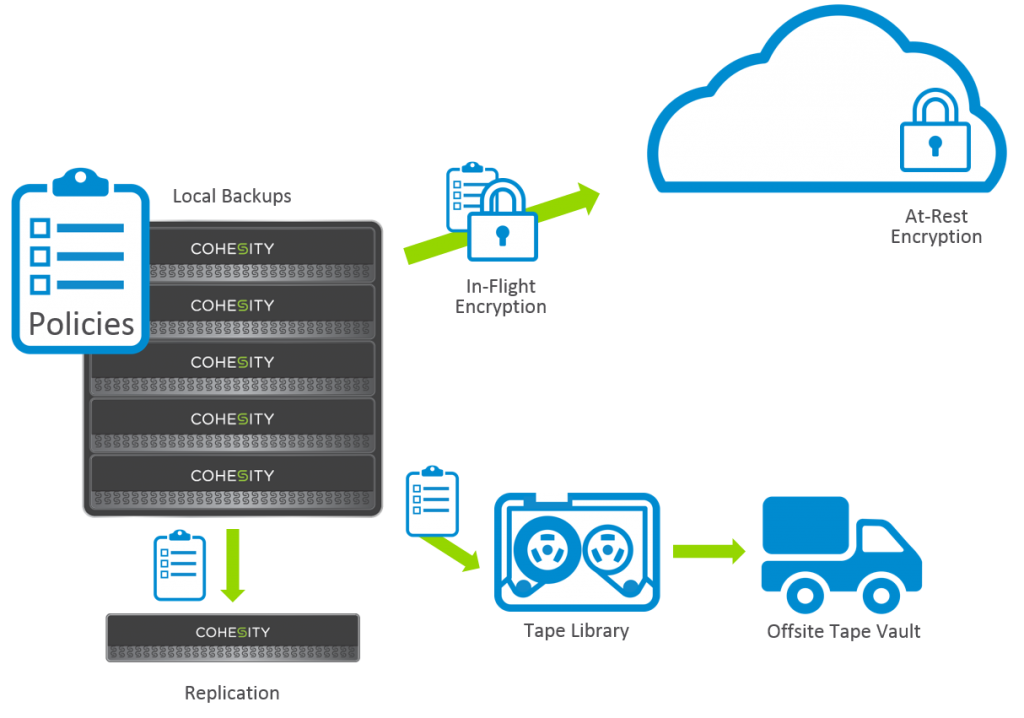[DISCLOSURE: Cohesity was one of the sponsors of the Storage Field Day 9 event (SFD9) that I was a delegate for. As such, they helped to pay for my travel, accommodations, and meals for that event. There was no requirement or even expectation that I write anything about them. No one from Cohesity (or anywhere else for that matter) has reviewed the content of this post.]
![]() Today, Cohesity announced the addition of Cloud integration with their storage platform.
Today, Cohesity announced the addition of Cloud integration with their storage platform.
Cohesity is a storage startup that, quite frankly, I hadn’t even heard of before receiving the invitation to Storage Field Day. In what may turn out to be a very clever strategy, Cohesity has made the conscious decision to let the existing players fight over the hotly-contested primary storage space. Instead, Cohesity is concentrating on capturing the less “sexy” — but just as important — secondary storage space.
In discussing this, Cohesity makes a “storage iceberg” analogy, wherein primary storage is only the part of the iceberg that’s visible above the surface, while secondary storage is everything below the surface: Tier 2/3 applications, copies of data, backups, archives, etc.
Cohesity’s platform to address this space is scale-out unified storage running its own file system, Cohesity Distributed File System (CDFS). The Cohesity platform can serve data via NFS, SMB, and S3. It offers data awareness and global data deduplication, both inline and post-process.
Today’s announcement bring into the present the Cloud “futures” Cohesity talked about at SFD9. The announcement consists of three parts:
- CloudArchive
- CloudTier
- CloudReplicate
Cloud Archive
CloudArchive allows Cohesity customers to archive data to the off-premises public Cloud service of their choice. For data that won’t be accessed again any time soon, this offers a great cost savings over adding and maintaining on-site storage for archival data.
Cohesity customers will have their choice of Cloud providers as CloudArchive offers integration with:
- Google Nearline
- Microsoft Azure
- Amazon S3
- Amazon Glacier
The diagram below gives a good visual depiction of this.
CloudTier
CloudTier provides a mechanism that allows customers the ability to use public Cloud as an extension of their on-premises storage. Based on policies set by the customer, data can be moved to the Cloud, transparent to the end-users.
Customers might use this to moved less-accessed or “cold” data to the Cloud. It can also be used to “cloud-burst” to seamlessly handle temporary or seasonal demands for storage capacity resources.
Cloud Replicate
CloudReplicate offers an easy Disaster Recovery solution that takes advantage of the public Cloud. It’s not actually Disaster Recovery as a Service (DRaaS), but more an enabler that allows customers to build their own DRaaS.
CloudReplicate works by running a virtual Cohesity instance as an Amazon EC2 virtual machine. The virtual instance will manage and serve Cloud storage in much the same way the physical Cohesity platform manages and serves disk storage.
Customers can then set their local Cohesity instance to replicate to the remote Cloud instance. In addition to providing an off-site copy of the customer’s data, CloudReplicate can be used for failover to the Cloud in the event of an outage at the local data center.
Availability
CloudArchive and CloudTier are available now to Cohestity customers who are running the latest release of the Cohesity Data Platform, 2.0, which was announced in February.
CloudReplicate is planned to be released for Production use later this year.
GeekFluent’s Thoughts
It’s still early days for Cohesity, so it’s hard to judge their long-term viability, but in my mind their prospects are good:
- It’s a tough market for start-ups to dive into the competition in the primary storage market. Unless you’re bringing something truly revolutionary, you set yourself up as a target to be crushed or bought. Coming up with a single coherent solution to address the secondary storage market is a smart move.
- More and more organizations are looking at Cloud-based storage solutions, either for use right now or in the very near future. Providing seamless integration to Cloud services while still offering customers their choice of service providers couldn’t be more timely.
I’ll be watching Cohesity with great interest in the days and months ahead. If they can keep deliver features and functionality at their current pace, I think there’s really something good here.

